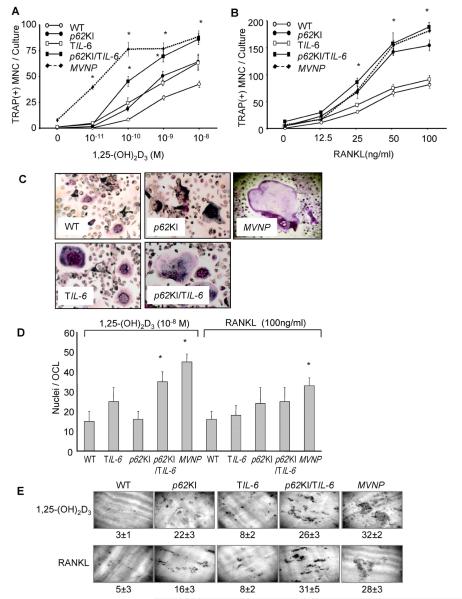Fig. 1.
Osteoclast formation in whole bone marrow cultures from WT, p62KI, TIL-6, p62KI/TIL-6, and MVNP mice. (A) OCL formation by treatment of 1,25-(OH)2D3. Data are expressed as the mean ± SD (n = 4); *p < 0.01, significantly different from OCLs formed with the same treatment in WT mouse cultures. (B) OCL formation by treatment of RANKL. Data are expressed as the mean ± SD (n = 4); *p < 0.01, significantly different from OCLs formed with the same treatment in WT mouse cultures. (C) Phenotype of OCLs formed from mouse bone marrow cultures. OCLs formed by 1,25-(OH)2D3 (1 × 10−8 M) were stained for TRAP. Magnification ×100. (D) Nuclei per OCL. The nuclear numbers per OCL were randomly counted in 25 OCLs formed in 1 × 10−8 M 1,25-(OH)2D3 or 100 ng/mL RANKL-treated cultures as in A and B. Data are expressed as the mean ± SD (n = 25); *p < 0.01, significantly different from OCLs formed with the same treatment in WT mouse cultures. (E) Bone resorption capacity of OCLs. Bone marrow cells were cultured for 7 days with 1,25-(OH)2D3 (1 × 10−8 M) or RANKL (100 ng/mL) on mammoth dentin slices. Values represent the amount of dentin surface resorption (%), mean ± SD (n = 4). WT = wild = type; OCL = osteoclast; 1,25-(OH)2D3 = 1,25-dihydroxyvitamin D3; TRAP = tartrate-resistant acid phosphatase; RANKL = receptor activator of NF-κB ligand.

